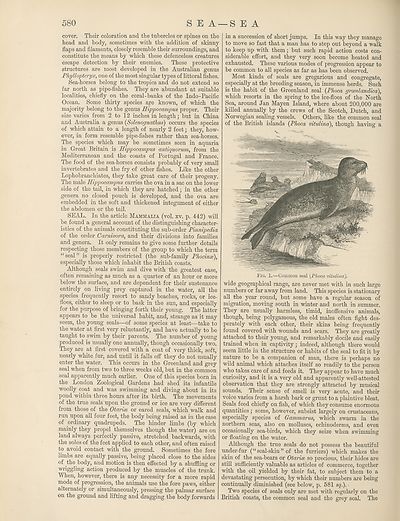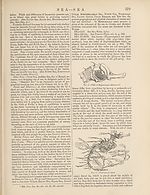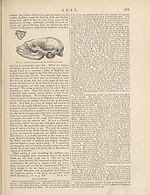Encyclopaedia Britannica > Volume 21, ROT-Siam
(590) Page 580
Download files
Complete book:
Individual page:
Thumbnail gallery: Grid view | List view

580
S E A —S E A
cover. Their coloration and the tubercles or spines on the
head and body, sometimes with the addition of skinny
flaps and filaments, closely resemble their surroundings, and
constitute the means by which these defenceless creatures
escape detection by their enemies. These protective
structures are most developed in the Australian genus
Phyllopteryx, one of the most singular types of littoral fishes.
Sea-horses belong to the tropics and do not extend so
far north as pipe-fishes. They are abundant at suitable
localities, chiefly on the coral-banks of the Indo-Pacific
Ocean. Some thirty species are known, of which the
majority belong to the genus Hippocampus proper. Their
size varies from 2 to 12 inches in length; but in China
and Australia a genus {Solenognaihus) occurs the species
of which attain to a length of nearly 2 feet; they, how¬
ever, in form resemble pipe-fishes rather than sea-horses.
The species which may be sometimes seen in aquaria
in Great Britain is Hippocampus antiquorum, from the
Mediterranean and the coasts of Portugal and France.
The food of the sea-horses consists probably of very small
invertebrates and the fry of other fishes. Like the other
Lophobranchiates, they take great care of their progeny.
The male Hippocampus carries the ova in a sac on the lower
side of the tail, in which they are hatched; in the other
genera no closed pouch is developed, and the ova are
embedded in the soft and thickened integument of either
the abdomen or the tail.
SEAL. In the article Mammalia (vol. xv. p. 442) will
be found a general account of the distinguishing character¬
istics of the animals constituting the sub-order Pinnipedia
of the order Carnivora, and their divisions into families
and genera. It only remains to give some further details
respecting those members of the group to which the term
“seal” is properly restricted (the sub-family Phocinx),
especially those which inhabit the British coasts.
Although seals swum and dive with the greatest ease,
often remaining as much as a quarter of an hour or more
below the surface, and are dependent for their sustenance
entirely on living prey captured in the water, all the
species frequently resort to sandy beaches, rocks, or ice¬
floes, either to sleep or to bask in the sun, and especially
for the purpose of bringing forth their young. The latter
appears to be the universal habit, and, strange as it may
seem, the young seals—of some species at least—take to
the water at first very reluctantly, and have actually to be
taught to swim by their parents. The number of young
produced is usually one annually, though occasionally two.
They are at first covered with a coat of very thick, soft,
nearly white fur, and until it falls off they do not usually
enter the wTater. This occurs in the Greenland and grey
seal wdien from two to three weeks old, but in the common
seal apparently much earlier. One of this species born in
the London Zoological Gardens had shed its infantile
woolly coat and was swimming and diving about in its
pond within three hours after its birth. The movements
of the true seals upon the ground or ice are very different
from those of the Otarix or eared seals, which walk and
run upon all four feet, the body being raised as in the case
of ordinary quadrupeds. The hinder limbs (by which
mainly they propel themselves though the water) are on
land always perfectly passive, stretched backwards, with
the soles of the feet applied to each other, and often raised
to avoid contact with the ground. Sometimes the fore
limbs are equally passive, being placed close to the sides
of the body, and motion is then effected by a shuffling or
wriggling action produced by the muscles of the trunk.
When, however, there is any necessity for a more rapid
mode of progression, the animals use the fore paws, either
alternately or simultaneously, pressing the palmar surface
on the ground and lifting and dragging the body forwards
in a succession of short jumps. In this way they manage
to move so fast that a man has to step out beyond a walk
to keep up with them; but such rapid action costs con¬
siderable effort, and they very soon become heated and
exhausted. These various modes of progression appear to
be common to all species as far as has been observed.
Most kinds of seals are gregarious and congregate,
especially at the breeding season, in immense herds. Such
is the habit of the Greenland seal {Phoca groenlandicd),
which resorts in the spring to the ice-floes of the North
Sea, around Jan Mayen Island, where about 200,000 are
killed annually by the crews of the Scotch, Dutch, and
Norwegian sealing vessels. Others, like the common seal
of the British islands {Phoca vitulina), though having a
v
Ida. 1.—Common seal {Phoca vitulina).
wide geographical range, are never met with in such large
numbers or far away from land. This species is stationary
all the year round, but some have a regular season of
migration, moving south in winter and north in summer.
They are usually harmless, timid, inoffensive animals,
though, being polygamous, the old males often fight des¬
perately with each other, their skins being frequently
found covered with W'ounds and scars. They are greatly
attached to their young, and remarkably docile and easily
trained when in captivity; indeed, although there would
seem little in the structure or habits of the seal to fit it by
nature to be a companion of man, there is perhaps no
wild animal which attaches itself so readily to the person
who takes care of and feeds it. They appear to have much
curiosity, and it is a very old and apparently well-attested
observation that they are strongly attracted by musical
sounds. Their sense of smell is very acute, and their
voice varies from a harsh bark or grunt to a plaintive bleat.
Seals feed chiefly on fish, of which they consume enormous
quantities; some, however, subsist largely on crustaceans,
especially species of Gammarus, which swarm in the
northern seas, also on molluscs, echinoderms, and even
occasionally sea-birds, which they seize when swimming
or floating on the water.
Although the true seals do not possess the beautiful
under-fur (“seal-skin” of the furriers) which makes the
skin of the sea-bears or Otarix so precious, their hides are
still sufficiently valuable as articles of commerce, together
with the oil yielded by their fat, to subject them to a
devastating persecution, by wdiich their numbers are being
continually diminished (see below, p. 581 sq.). •
Two species of seals only are met with regularly on the
British coasts, the common seal and the grey seal. The
S E A —S E A
cover. Their coloration and the tubercles or spines on the
head and body, sometimes with the addition of skinny
flaps and filaments, closely resemble their surroundings, and
constitute the means by which these defenceless creatures
escape detection by their enemies. These protective
structures are most developed in the Australian genus
Phyllopteryx, one of the most singular types of littoral fishes.
Sea-horses belong to the tropics and do not extend so
far north as pipe-fishes. They are abundant at suitable
localities, chiefly on the coral-banks of the Indo-Pacific
Ocean. Some thirty species are known, of which the
majority belong to the genus Hippocampus proper. Their
size varies from 2 to 12 inches in length; but in China
and Australia a genus {Solenognaihus) occurs the species
of which attain to a length of nearly 2 feet; they, how¬
ever, in form resemble pipe-fishes rather than sea-horses.
The species which may be sometimes seen in aquaria
in Great Britain is Hippocampus antiquorum, from the
Mediterranean and the coasts of Portugal and France.
The food of the sea-horses consists probably of very small
invertebrates and the fry of other fishes. Like the other
Lophobranchiates, they take great care of their progeny.
The male Hippocampus carries the ova in a sac on the lower
side of the tail, in which they are hatched; in the other
genera no closed pouch is developed, and the ova are
embedded in the soft and thickened integument of either
the abdomen or the tail.
SEAL. In the article Mammalia (vol. xv. p. 442) will
be found a general account of the distinguishing character¬
istics of the animals constituting the sub-order Pinnipedia
of the order Carnivora, and their divisions into families
and genera. It only remains to give some further details
respecting those members of the group to which the term
“seal” is properly restricted (the sub-family Phocinx),
especially those which inhabit the British coasts.
Although seals swum and dive with the greatest ease,
often remaining as much as a quarter of an hour or more
below the surface, and are dependent for their sustenance
entirely on living prey captured in the water, all the
species frequently resort to sandy beaches, rocks, or ice¬
floes, either to sleep or to bask in the sun, and especially
for the purpose of bringing forth their young. The latter
appears to be the universal habit, and, strange as it may
seem, the young seals—of some species at least—take to
the water at first very reluctantly, and have actually to be
taught to swim by their parents. The number of young
produced is usually one annually, though occasionally two.
They are at first covered with a coat of very thick, soft,
nearly white fur, and until it falls off they do not usually
enter the wTater. This occurs in the Greenland and grey
seal wdien from two to three weeks old, but in the common
seal apparently much earlier. One of this species born in
the London Zoological Gardens had shed its infantile
woolly coat and was swimming and diving about in its
pond within three hours after its birth. The movements
of the true seals upon the ground or ice are very different
from those of the Otarix or eared seals, which walk and
run upon all four feet, the body being raised as in the case
of ordinary quadrupeds. The hinder limbs (by which
mainly they propel themselves though the water) are on
land always perfectly passive, stretched backwards, with
the soles of the feet applied to each other, and often raised
to avoid contact with the ground. Sometimes the fore
limbs are equally passive, being placed close to the sides
of the body, and motion is then effected by a shuffling or
wriggling action produced by the muscles of the trunk.
When, however, there is any necessity for a more rapid
mode of progression, the animals use the fore paws, either
alternately or simultaneously, pressing the palmar surface
on the ground and lifting and dragging the body forwards
in a succession of short jumps. In this way they manage
to move so fast that a man has to step out beyond a walk
to keep up with them; but such rapid action costs con¬
siderable effort, and they very soon become heated and
exhausted. These various modes of progression appear to
be common to all species as far as has been observed.
Most kinds of seals are gregarious and congregate,
especially at the breeding season, in immense herds. Such
is the habit of the Greenland seal {Phoca groenlandicd),
which resorts in the spring to the ice-floes of the North
Sea, around Jan Mayen Island, where about 200,000 are
killed annually by the crews of the Scotch, Dutch, and
Norwegian sealing vessels. Others, like the common seal
of the British islands {Phoca vitulina), though having a
v
Ida. 1.—Common seal {Phoca vitulina).
wide geographical range, are never met with in such large
numbers or far away from land. This species is stationary
all the year round, but some have a regular season of
migration, moving south in winter and north in summer.
They are usually harmless, timid, inoffensive animals,
though, being polygamous, the old males often fight des¬
perately with each other, their skins being frequently
found covered with W'ounds and scars. They are greatly
attached to their young, and remarkably docile and easily
trained when in captivity; indeed, although there would
seem little in the structure or habits of the seal to fit it by
nature to be a companion of man, there is perhaps no
wild animal which attaches itself so readily to the person
who takes care of and feeds it. They appear to have much
curiosity, and it is a very old and apparently well-attested
observation that they are strongly attracted by musical
sounds. Their sense of smell is very acute, and their
voice varies from a harsh bark or grunt to a plaintive bleat.
Seals feed chiefly on fish, of which they consume enormous
quantities; some, however, subsist largely on crustaceans,
especially species of Gammarus, which swarm in the
northern seas, also on molluscs, echinoderms, and even
occasionally sea-birds, which they seize when swimming
or floating on the water.
Although the true seals do not possess the beautiful
under-fur (“seal-skin” of the furriers) which makes the
skin of the sea-bears or Otarix so precious, their hides are
still sufficiently valuable as articles of commerce, together
with the oil yielded by their fat, to subject them to a
devastating persecution, by wdiich their numbers are being
continually diminished (see below, p. 581 sq.). •
Two species of seals only are met with regularly on the
British coasts, the common seal and the grey seal. The
Set display mode to:
![]() Universal Viewer |
Universal Viewer | ![]() Mirador |
Large image | Transcription
Mirador |
Large image | Transcription
Images and transcriptions on this page, including medium image downloads, may be used under the Creative Commons Attribution 4.0 International Licence unless otherwise stated. ![]()
| Encyclopaedia Britannica > Encyclopaedia Britannica > Volume 21, ROT-Siam > (590) Page 580 |
|---|
| Permanent URL | https://digital.nls.uk/193634949 |
|---|
| Attribution and copyright: |
|
|---|---|
| Shelfmark | EB.17 |
|---|---|
| Description | Ten editions of 'Encyclopaedia Britannica', issued from 1768-1903, in 231 volumes. Originally issued in 100 weekly parts (3 volumes) between 1768 and 1771 by publishers: Colin Macfarquhar and Andrew Bell (Edinburgh); editor: William Smellie: engraver: Andrew Bell. Expanded editions in the 19th century featured more volumes and contributions from leading experts in their fields. Managed and published in Edinburgh up to the 9th edition (25 volumes, from 1875-1889); the 10th edition (1902-1903) re-issued the 9th edition, with 11 supplementary volumes. |
|---|---|
| Additional NLS resources: |
|

